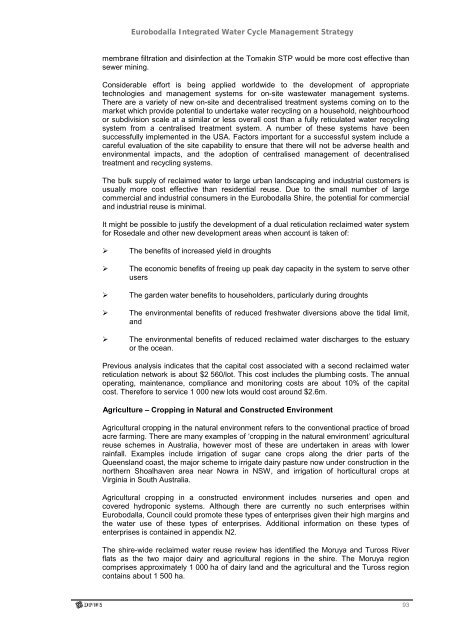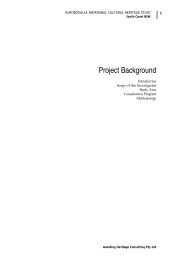Eurobodalla Integrated Water Cycle Management Strategy
Eurobodalla Integrated Water Cycle Management Strategy
Eurobodalla Integrated Water Cycle Management Strategy
You also want an ePaper? Increase the reach of your titles
YUMPU automatically turns print PDFs into web optimized ePapers that Google loves.
<strong>Eurobodalla</strong> <strong>Integrated</strong> <strong>Water</strong> <strong>Cycle</strong> <strong>Management</strong> <strong>Strategy</strong><br />
membrane filtration and disinfection at the Tomakin STP would be more cost effective than<br />
sewer mining.<br />
Considerable effort is being applied worldwide to the development of appropriate<br />
technologies and management systems for on-site wastewater management systems.<br />
There are a variety of new on-site and decentralised treatment systems coming on to the<br />
market which provide potential to undertake water recycling on a household, neighbourhood<br />
or subdivision scale at a similar or less overall cost than a fully reticulated water recycling<br />
system from a centralised treatment system. A number of these systems have been<br />
successfully implemented in the USA. Factors important for a successful system include a<br />
careful evaluation of the site capability to ensure that there will not be adverse health and<br />
environmental impacts, and the adoption of centralised management of decentralised<br />
treatment and recycling systems.<br />
The bulk supply of reclaimed water to large urban landscaping and industrial customers is<br />
usually more cost effective than residential reuse. Due to the small number of large<br />
commercial and industrial consumers in the <strong>Eurobodalla</strong> Shire, the potential for commercial<br />
and industrial reuse is minimal.<br />
It might be possible to justify the development of a dual reticulation reclaimed water system<br />
for Rosedale and other new development areas when account is taken of:<br />
The benefits of increased yield in droughts<br />
The economic benefits of freeing up peak day capacity in the system to serve other<br />
users<br />
The garden water benefits to householders, particularly during droughts<br />
The environmental benefits of reduced freshwater diversions above the tidal limit,<br />
and<br />
The environmental benefits of reduced reclaimed water discharges to the estuary<br />
or the ocean.<br />
Previous analysis indicates that the capital cost associated with a second reclaimed water<br />
reticulation network is about $2 560/lot. This cost includes the plumbing costs. The annual<br />
operating, maintenance, compliance and monitoring costs are about 10% of the capital<br />
cost. Therefore to service 1 000 new lots would cost around $2.6m.<br />
Agriculture – Cropping in Natural and Constructed Environment<br />
Agricultural cropping in the natural environment refers to the conventional practice of broad<br />
acre farming. There are many examples of ‘cropping in the natural environment’ agricultural<br />
reuse schemes in Australia, however most of these are undertaken in areas with lower<br />
rainfall. Examples include irrigation of sugar cane crops along the drier parts of the<br />
Queensland coast, the major scheme to irrigate dairy pasture now under construction in the<br />
northern Shoalhaven area near Nowra in NSW, and irrigation of horticultural crops at<br />
Virginia in South Australia.<br />
Agricultural cropping in a constructed environment includes nurseries and open and<br />
covered hydroponic systems. Although there are currently no such enterprises within<br />
<strong>Eurobodalla</strong>, Council could promote these types of enterprises given their high margins and<br />
the water use of these types of enterprises. Additional information on these types of<br />
enterprises is contained in appendix N2.<br />
The shire-wide reclaimed water reuse review has identified the Moruya and Tuross River<br />
flats as the two major dairy and agricultural regions in the shire. The Moruya region<br />
comprises approximately 1 000 ha of dairy land and the agricultural and the Tuross region<br />
contains about 1 500 ha.<br />
93

















